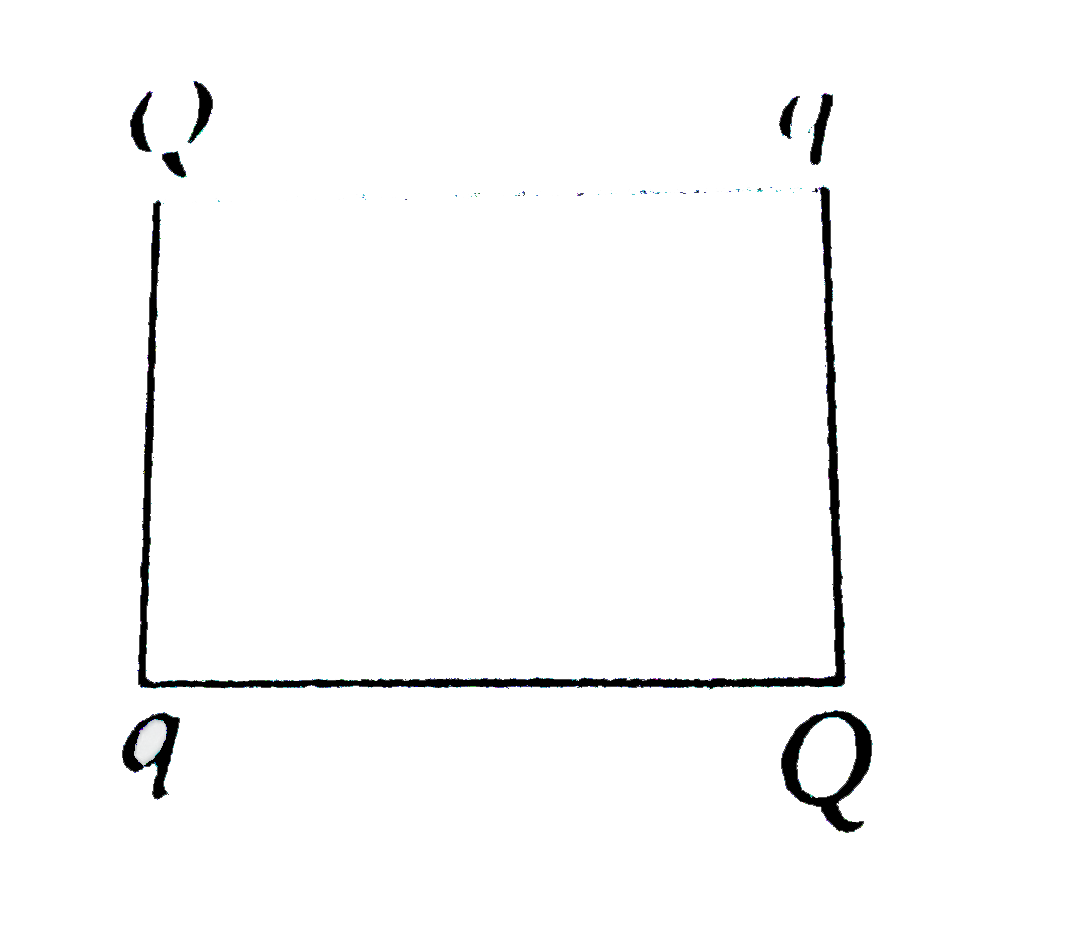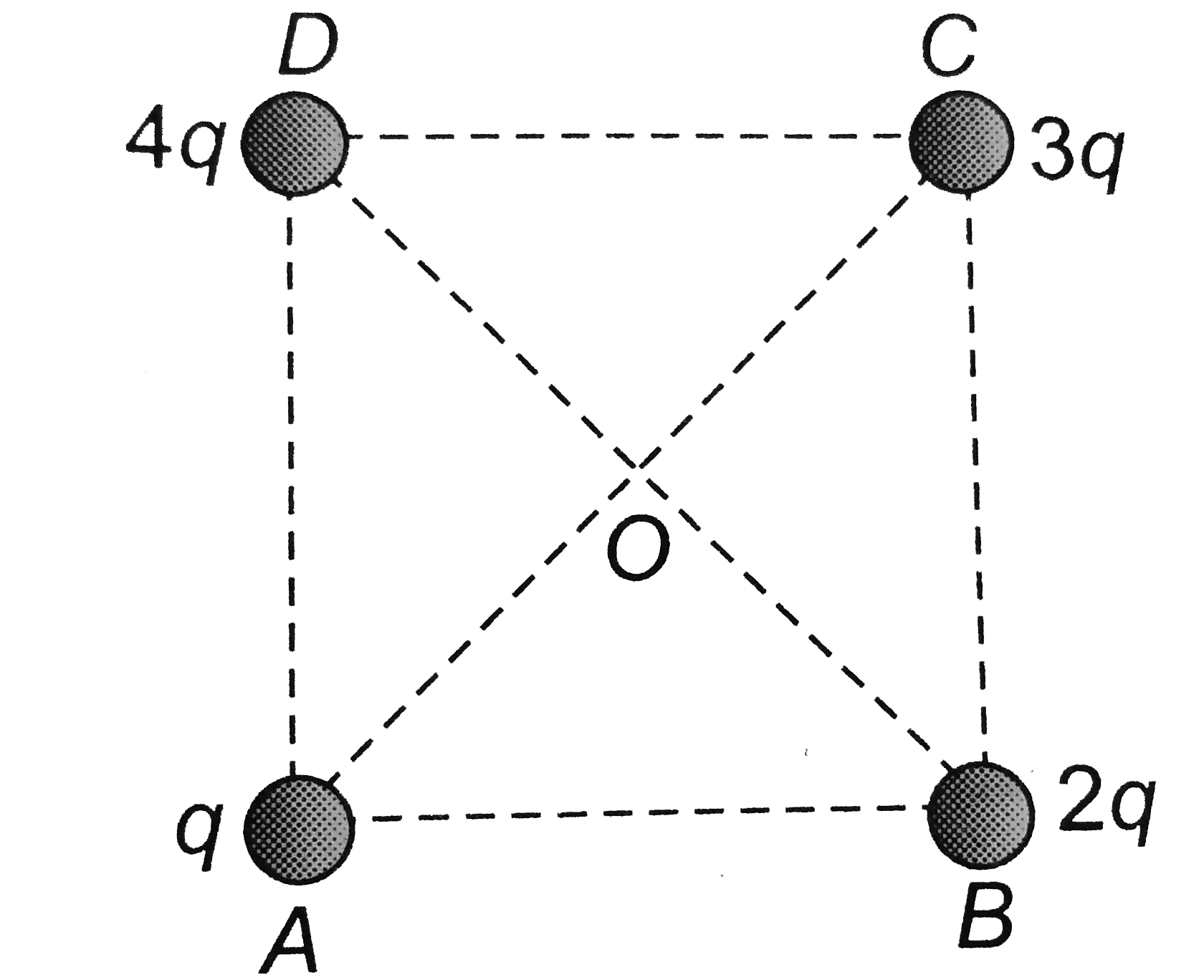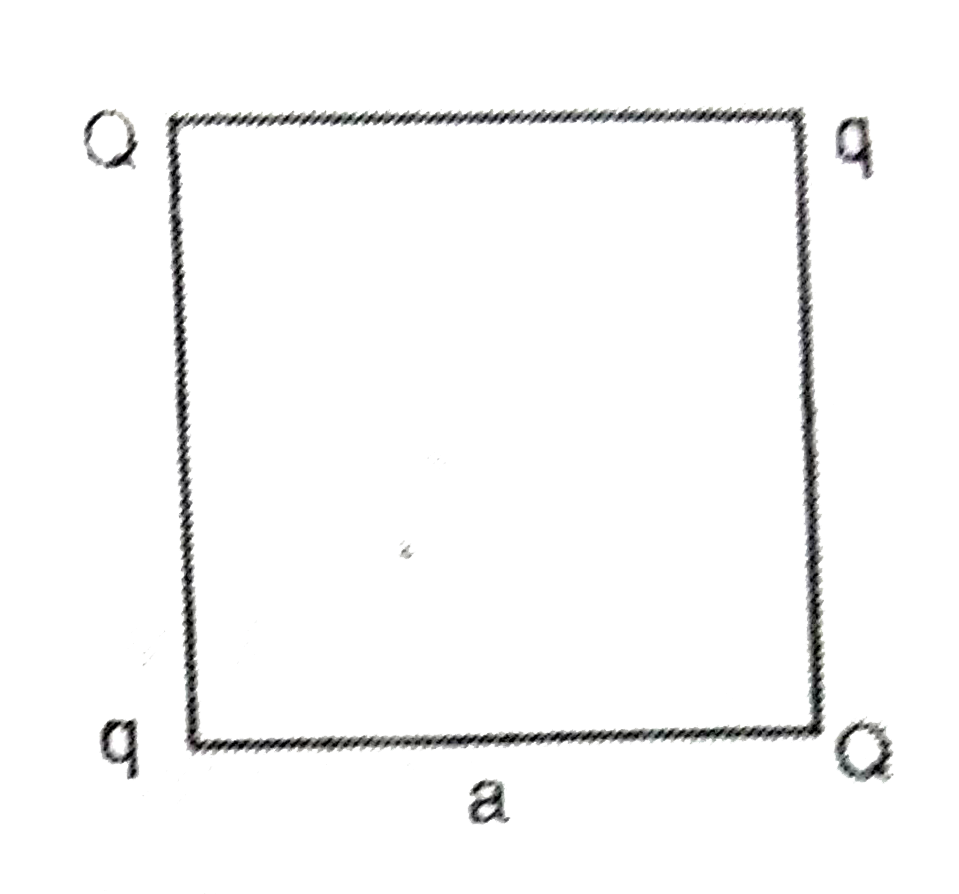Four point charges −Q,−q,2q and 2Q are placed, one at each corner of the square. The relation between Q and q for which the potential at the centre of the square is zero is
Q=−q
Q=−1q
Q=q
Q=1q
The correct Answer is:A
To find the relation between the charges Q and q such that the electric potential at the center of the square is zero, we can follow these steps:
Step 1: Understand the Configuration
We have four charges placed at the corners of a square:
- Charge at corner A: −Q
- Charge at corner B: −q
- Charge at corner C: 2q
- Charge at corner D: 2Q
Step 2: Determine the Distance to the Center
For a square with side length a, the distance from each corner to the center (O) is given by:
R=a√2
Step 3: Calculate the Potential at the Center
The electric potential V at a point due to a point charge is given by:
V=kQr
where k is Coulomb's constant, Q is the charge, and r is the distance from the charge to the point.
The total potential at the center O due to all four charges is:
VO=VA+VB+VC+VD
Substituting the values:
VO=k(−Q)R+k(−q)R+k(2q)R+k(2Q)R
Factoring out kR:
VO=kR(−Q−q+2q+2Q)
Simplifying the expression inside the parentheses:
VO=kR(Q+q)
Step 4: Set the Total Potential to Zero
For the potential at the center to be zero:
kR(Q+q)=0
Since k and R are not zero, we can set the expression inside the parentheses to zero:
Q+q=0
Step 5: Solve for the Relation Between Q and q
This gives us:
Q=−q
Conclusion
The relation between Q and q for which the potential at the center of the square is zero is:
Q=−q
We have four charges placed at the corners of a square:
- Charge at corner A: −Q
- Charge at corner B: −q
- Charge at corner C: 2q
- Charge at corner D: 2Q
For a square with side length a, the distance from each corner to the center (O) is given by:
R=a√2
The electric potential V at a point due to a point charge is given by:
V=kQr
where k is Coulomb's constant, Q is the charge, and r is the distance from the charge to the point.
VO=VA+VB+VC+VD
Substituting the values:
VO=k(−Q)R+k(−q)R+k(2q)R+k(2Q)R
Factoring out kR:
VO=kR(−Q−q+2q+2Q)
Simplifying the expression inside the parentheses:
VO=kR(Q+q)
For the potential at the center to be zero:
kR(Q+q)=0
Since k and R are not zero, we can set the expression inside the parentheses to zero:
Q+q=0
This gives us:
Q=−q
The relation between Q and q for which the potential at the center of the square is zero is:
Q=−q
Topper's Solved these Questions
- ELECTROSTATIC POTENTIAL AND CAPACITORSBOOK - DC PANDEY ENGLISHCHAPTER - ELECTROSTATIC POTENTIAL AND CAPACITORSEXERCISE - (B) Chapter exercises
17 Videos
- ELECTROMAGNETIC WAVESBOOK - DC PANDEY ENGLISHCHAPTER - ELECTROMAGNETIC WAVESEXERCISE - Sec C
22 Videos
- ELECTROSTATICSBOOK - DC PANDEY ENGLISHCHAPTER - ELECTROSTATICSEXERCISE - Medical entrances gallery
37 Videos
Similar Questions
Four charge Q,q,Q and q are kept at the four corners of a square as shown below. What is the relation between Q and q, so that the net force on a charge q is zero ?

View SolutionCharges q,2q,3q and 4q are placed at the corners A,B,C and D of a square as shown in the following figure. The directon of electric field at the centre of the square is along

View SolutionCharges q,2q,3q and 4q are placed at the corners A,B,C and D of a square as shown in the following figure. The directon of electric field at the centre of the square is along

View SolutionFour charges of +q, +q +q and +q are placed at the corners A, B, C and D of s square. The resultant force on the charge at D
View SolutionA charge Q is placed at each corner of a cube of side a. The potential at the centre of the cube is
View SolutionFour point charge q,−q,2Q and Q are placed in order at the corners A, B, C and D of a square. If the field at the midpoint of CD is zero then the value of q/Q is 5√5x. Find the value of x.
View SolutionFour charges of +q, +q +q and +q are placed at the corners A, B, C and D of s square. The resultant force on the charge at D
View SolutionIf identical charges (−q) are placed at each corner of a cube of side b, then electric potential energy of charge (+q) which is placed at centre of the cube will be
View SolutionFour point charges Q, q, Q and q are placed at the corners of a square of side' a' as shown in the figure.
Find the .
(a) resultnat electric force on a charge Q and .
(b) potential energy of this system.

View SolutionFour identical charges each .q. are placed at four corners of a square of side .a.. Find the charge to be placed at the centre of the square so that the system of charges is in equilibrium
View Solution
